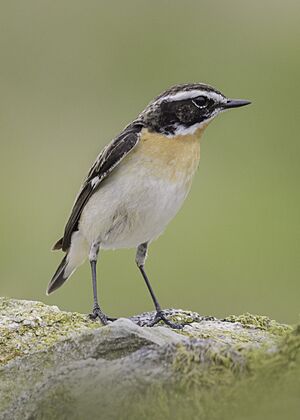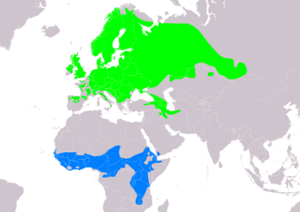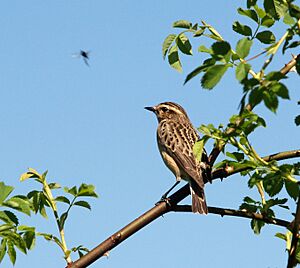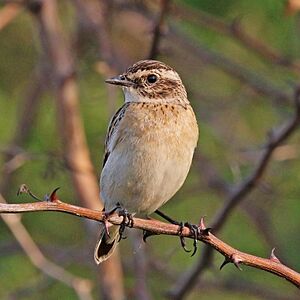Whinchat facts for kids
Quick facts for kids Whinchat |
|
|---|---|
 |
|
| Adult male in breeding plumage | |
| Conservation status | |
| Scientific classification | |
| Genus: |
Saxicola
|
| Species: |
rubetra
|
 |
|
| Range of S. rubetra (Compiled by: BirdLife International and Handbook of the Birds of the World (2016) 2016.) Breeding Non-breeding | |
| Synonyms | |
|
|
The whinchat (Saxicola rubetra) is a small migratory bird. It breeds in Europe and western Asia. When winter comes, it flies all the way to central Africa.
This bird used to be thought of as a type of thrush. Now, scientists know it belongs to the Old World flycatcher family. Both male and female whinchats have a clear stripe above their eye, called a supercilium. Their upper parts are brownish with darker spots. They have a pale throat and chest, a light belly, and a dark tail with white at the base of the outer feathers.
During the breeding season, the male whinchat looks special. His throat and chest turn a bright orange-buff color.
Whinchats are usually found alone. They like open grassy areas with some rough plants and small bushes. They often sit on high spots. From there, they watch for insects and other tiny creatures to eat.
The female builds her nest on the ground, hidden in thick plants. She lays four to seven eggs. The mother bird sits on the eggs for about 13 days. After the chicks hatch, both parents feed them. The young birds leave the nest after about 18 days. Their parents keep feeding them for two more weeks.
Whinchats change their feathers in late summer before flying south. They change feathers again in Africa before flying north in spring. The whinchat is a common bird. Its population is stable, so it is listed as "least concern" by conservation groups.
Contents
What's in a Name?
The whinchat's name comes from two parts. "Whin" refers to a plant called common gorse, which grows where these birds live. "Chat" describes the sounds the bird makes.
Its scientific name, Saxicola rubetra, also tells us about the bird. Saxicola means "small rock-dweller" in Latin. This describes its habitat, or where it lives. Rubetra is a Latin word for a small bird. There are no different types (subspecies) of whinchats known.
Scientists used to group the whinchat with thrushes. But now, they know it is part of the Old World flycatcher family. Birds like the whinchat that are in the flycatcher family but look a bit like thrushes are often called "chats."
Whinchat Description
The whinchat is a small bird with a short tail. It moves on the ground by hopping quickly. It often bobs its head and flicks its wings and tail. It is about the same size as a European robin. Whinchats are about 12 to 14 centimeters (5 to 5.5 inches) long. They weigh between 13 and 26 grams (0.4 to 0.9 ounces).
Both male and female whinchats have brownish upper parts with darker spots. They have a buff-colored throat and chest. Their belly is pale buff to whitish. Their tail is dark with white at the base of the outer feathers.
When breeding, the male whinchat has a dark face. This mask is almost surrounded by a strong white stripe above its eye (supercilium) and a white stripe on its cheek. His throat and chest are a bright orange-buff. He also has small white patches on his wings.
The female whinchat is not as brightly colored. Her face mask is browner. Her chest is pale buffy-brown. Her supercilium and cheek stripe are buff. Her white wing patches are smaller or missing. Young males and males in winter look similar to females. However, adult males keep their white wing patches all year.
Whinchats can be confused with other birds like the European stonechat. But you can tell a whinchat by its clear supercilium and whiter belly. Whinchats are also a bit slimmer. They have longer wingtips, which helps them fly long distances during migration.
The whinchat's main call sounds like hue-tac-tac. The 'tac' sound is softer than that of the European stonechat. This call is used to talk to other birds or to warn about danger. The male whinchat has a soft, whistling song during the breeding season. It often copies sounds from other birds. He sings from a fence, bush, tree, or wire.
Where Whinchats Live
The whinchat is a bird that migrates. It breeds in Europe and western Asia. This area stretches from Ireland to Russia. It also goes from northern Norway down to Spain, Italy, Greece, and the Caucasus Mountains.
Birds arrive at their breeding places between late April and mid-May. They leave between mid-August and mid-September. They spend the winter mainly in tropical sub-Saharan Africa. This area goes from Senegal to Kenya and south to Zambia. They arrive in Africa in late September to November. They leave between February and March. Some whinchats also spend winter in northwestern Africa.
During the breeding season, whinchats in the UK like places with many different kinds of plants. They also prefer steeper slopes. But in their own small areas, they like lower spots with different types of plants. They also need many places to perch, like bushes or tall grasses.
Whinchat Behavior and Life Cycle
Whinchats are mostly solitary birds. This means they like to be alone. However, they might form small family groups in autumn. They prefer habitats with rough, low plants. This includes open pastures or grasslands that are not farmed too much. They like areas with scattered small bushes like hawthorn or bracken. They also live in new conifer tree plantations until the trees grow too tall. They always need a few high spots to sit on. These spots help them look for food and sing their songs.
Reproduction and Young Birds
Breeding happens in late April and May. Only the female builds the nest. She uses dried grasses and moss. She lines it with hairs and fine grass. The nest is built on the ground, hidden in thick, low plants. It is often at the bottom of a bush.
The female lays four to seven eggs. She sits on them for 11 to 14 days until they hatch. Both parents bring food to the young birds. The young leave the nest when they are 10 to 14 days old. At this age, they are still too young to fly well. The chicks can fly about 17 to 19 days after hatching. They still rely on their parents for about two more weeks.
Whinchats usually live for only about two years. The longest recorded life for a whinchat in the wild is just over five years. They start breeding when they are one year old.
What Whinchats Eat
Whinchats are insect-eaters. They mostly eat insects, which make up about 80-90% of their diet. They also eat other small creatures like spiders, tiny snails, and worms. In autumn, they eat small amounts of fruit, like blackberries.
These birds like to sit on high spots, such as bushes. From there, they fly out to catch insects. Most insects are caught off the ground, but they also catch flying insects. When perched, males often flick their tail and sometimes their wings. This shows off the white parts of their tail and wings. This is a way for them to communicate with other whinchats.
Status and Conservation
The whinchat is quite common across the large area where it lives. Because of this, the International Union for Conservation of Nature says it is a species of "least concern". This means it is not currently in danger of disappearing.
However, some whinchat populations are shrinking. This is especially true in western Europe, like in Britain, Ireland, France, and Germany. This decline is mainly due to modern farming methods. These methods change the habitats that whinchats need to survive.
In Britain, the whinchat population is listed as "amber." This means its conservation status is not good. It has almost disappeared from lowland areas in the south and east. It is still common only in upland areas where farming is less intense. There has been a similar decline in Ireland, where it is now considered "rare."






